|
|
 |
|
Analog Echo Timeline
|
|
Jan 4th 1951
"How High the Moon" Les Paul & Mary Ford

|
At the very roots of tape echo and delay, Les Paul is the man to thank. Prior to 1951, all echo and delay was created naturally with the use of echo chambers, large rooms, tubes or process called line delay. Line delay was created by transmiting a signal out over a phone line to a city many hundreds of miles away and then back again. The time it took for the signal to complete the outward and return journey back along the phone line would be the length of delay.Working with one of the first Ampex tape machines in the studio Paul discovered that the playback head reproduced the incoming signal milliseconds later than the record head captured it. He also realized by varying the space between the heads, this delay time could be made shorter or longer. Blended with the direct sound of his guitar, he created a single repeat "slap-back" echo effect. This became a staple of Pauls tone on his many of his early 50's hits. Paul also discoverd that by shortening and "looping" the tape on the reel, he could make the effect infinite, but this effect was still only achievable in the studio.
|
|
|
1953
EchoSonic amplifier
Tube/Tape

|
Ray Butts of Cairo, Illinois designed and built the ground breaking EchoSonic amplifier. This was a 25-watt, 6L6-powered, 1x12 combo that housed a magnetic tape echo unit in the bottom of its cabinet. The first echosonic ampifier was built for a local guitar player named Bill Gwaltney. Only 68 of these Echosonic amplifiers were ever made.
|
|
|
1953-54
Binson Ecorec
Tube/Magnetic Disc
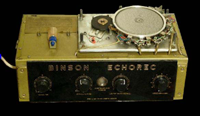
|
The key to the success of the Italian built Binson Echorec was a memory disc, which was more durable and stable then the magnetic tape. The first batch of Ecorec machines were manufactured around 1953/54. It's thought that no more than thirty units were built.
|
|
|
1954
EchoSonic amplifier
Tube/tape
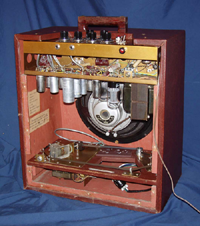
|
Ray Butts drove to Nashville and called Chet Atkins to demonstrate the second echosonic amplifier. Chet purchased the EchoSonic from $395 and a trade in of a 100$ Fender combo. Later using it for a Famous Grand Ole Opry performance.
|
|
|
1954
Sam Phillips and his Ampex tape machines

|
Sam Phillips producer at Sun Studios in Memphis had an Ampex tape machine installed solely to recreate Les Pauls "slap echo" effect. Most notably this effect can be heard with the guitar playing of Scotty Moore on Elvis Presley's first big hit, "That's Alright".
|
|
|
1955-63
Binson Echorec
Tube/Magnetic Disk

|
It is believed that the first Echorec in it's definitive form was built around 1955 and this model was manufactured up until 1962/63.
|
|
|
1955
EchoSonic amplifier
Tube/Tape
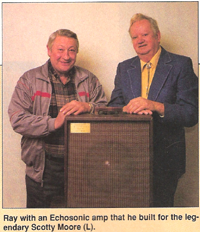
|
Scotty Moore heard Atkins amplifer on the radio and contacted Butts about getting one built.
|
|
|
1958-1959
Eccofonic
Tube/Tape
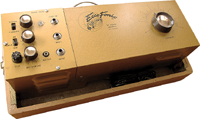
|
Ray Stolle built the Eccofonic prototype and later that year it was put into a tweed case and marketed under the Fender name until 1959.
|
|
|
1958-1959
Watkins Copicat MK I
Tube/Tape
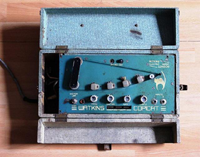
|
The same year that Ray Stolle was building his Eccofonic prototype, Charlie Watkins in Britan was building the original Copicat.
|
|
|
1960-1964
Watkins Copicat MK II
Tube/Tape
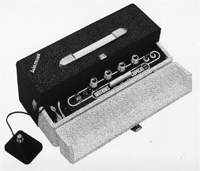
|
The MKII Copicat saw the old rotary head switching of the MKI replaced with a pushbutton assembly.
|
|
|
1958-1966
Binson "Baby Binson"
Tube/Magnetic disc
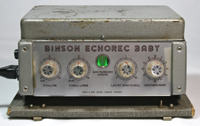
|
The Italian born Baby Binson was introduced around 1958. These were primarily aimed at guitar players.
|
|
|
1959
Dynachord Echocord
Tube/Tape
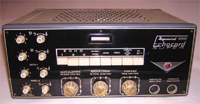
|
Early Dynacord echoes were nearly identical to those from another German company, Klemt. One of the odd drawbacks of these German machines was their use of five-pin DIN sockets for the inputs and outputs
|
|
|
1959
Klemt Echolette
Tube/Tape
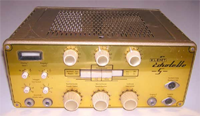
|
Klemt buit in Germany.
|
|
|
1959
Meazzi Echomatic 1
Tube/Tape & Magnetic Disk
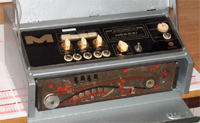
|
The Italian company Meazzi offered a number of different echo units, magnetic drum and tape versions. Vox sold multiple versions of the Meazzi echo unit from 1959 through 1962 under their name utliizing a magnetically treated disk as a recording medium.
|
|
|
1959
Echoplex prototype
Tube/Tape
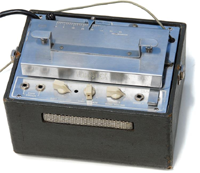
|
Mike Battle loosly copied the design of the echo unit found in the Echosonic amp and built it into a portable unit. The bigest innovation was a movable head to change the delay time.
|
|
|
1960
Eccofonic 109b
Tube/Tape
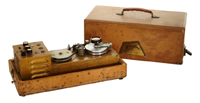
|
These were the same unit as the original Eccofonic echo units sold by Fender, but in 1960 they began marketing under the Eccofonic name exclusivly.
|
|
|
1961
EchoPlex Ep 1
Tube/Tape

|
The First Echoplex are marketed.
|
|
|
1962
"Maestro" EchoPlex Ep 1
Tube/Tape

|
The Echoplex name is bought by Market Electronics and marketed under their brand "Maestro".
|
|
|
1962
JMI Vox Domino Echo
Tube/tape

|
The Domino featured 3 echo settings (Fast,Medium,Slow), 2 channels with gain for each and controls for reverb and swell. Switchable power supply for 110/240v, and an on/off switch for the motor.
|
|
|
1962
Schaller Echo Sound
Tube/tape

|
The German built Schaller Echo-Sound delay unit used a ferro oxide-coated spinning drum, similar operational principle as the Binson EchoRec.
|
|
|
1962
Swiss Echo
Tube/tape

|
The Swissecho echo unit appeared in the Selmer catalogue from about 1962 to 1965. It was later joined around 1963 by a Swissecho combination PA/Tape Echo Unit.
|
|
|
1963-1966
Fender Electronic Echo chamber
Solidstate/tape
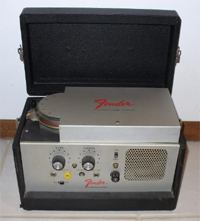
|
The Fender Electronic Echo Chamber was a solidstate version of the old Ecco-fonic built by Eccofonic (now owned by Automata) Fender. This became Fenders first solid state effect. It featured movable heads, but lacked the "sound on sound" feature of the echoplex. Ths version was produced until 1966.
|
|
|
1963
JIM Vox"Short Tom" Echo Standard
Tube/tape
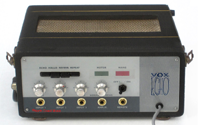
|
Introduced in 1963 the short tom was the 3rd generation of echos from Vox. Built by Meazzi it featured 3 channels with echo selections for Echo, Hallo, Reveb and Repeat. The only ajustmaent was a single knob to balance the wet/dry signal. You would pull/push the knob to start and stop the tape motor.
|
|
|
1964-1968
JMI Vox "Long Tom" Echo Deluxe MkII
Tube/tape
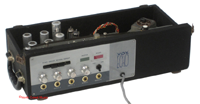
|
Built by Meazzi the long tom featured 3 channels with echo selections for Echo, Hallo, Reveb and Repeat. The only ajustmaent was a single knob to balance the wet/dry signal. You would pull.push the knob to start and stop the tape motor.
|
|
|
1960's
Selmer Truvoice Echo 200
Tube/tape

|
Rare unit with 3 fixed time selection options: off, first head (short), second head (medium), Both (Short and Medium).
|
|
|
1963-?
Eccofonic unidentified model
Solidstate/tape

|
I personally own this unidentified echo unit which utilizes the exact same circuitry, drive, and metal interior mountings as the solid state Fender Electronic Echo Chambers built by Eccofonic/Automata. The carrying case is larger and the controls are oriented on the top under the hinged cover instead of the face via a plate on that is attached to the front of the original EEC chassis. Most everything else is identical, right down to the serial number decal. This model has all of the features as the Fenderi EEC, plus one additionl feature, a switch labled "playback" that disables the erase/write heads to create a sound on sound loop. I have verified that this addition can be preformed on all of the Fender EEC units as well. My guess is this unit was likely a prototype from Eccofonic/Automata or a very small run. The playback feature was likely an attempt to compete with the Echoplex "sound on sound" feature. I have never seen another one like this one, or even a picture of another.
|
|
|
Mid 1960's
Oil can delay
Tube/solidstate/Oil Can

|
Ray Lubow (Tel-Ray) invents electrostatic oil can delay "Adineko Memory System"
Licensed to Fender, Gibson, Rickenbaker, Standel, Acoustic, Univox, Vox until TelRay changed their name to Morley in the 70's.
TelRay Ad-n-echo (2 knob)

TelRay Ad-n-echo (3 knob)

TelRay Echo-ver-brato
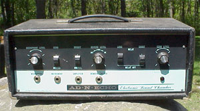
TelRay Variable Delay
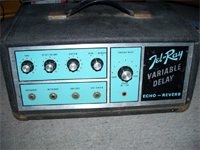
TelRay Vagrant Repeat Echo E 10
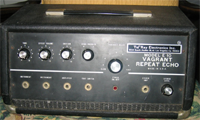
Standel Reverbalux
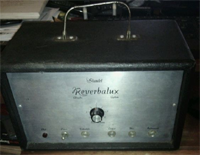
Fender Echo Reverb I
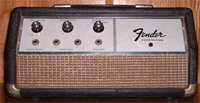
Fender Echo Reverb II

Fender Echo Reverb III
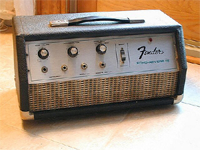
Fender Variably Delay

Fender Dimension IV (small)
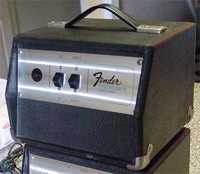
Fender Dimension IV (large)
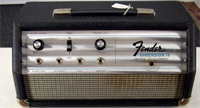
Fender Special Effect Center
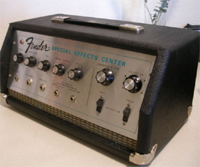
Fender Multi-Echo

Gibson GA-4RE 1965-67

Acoustic Reverbarato

Morley Electrostatic Delay Line (SS) 70's

Morley 747ms Delay (SS)

Morley EVO-1
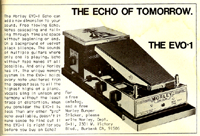
There were also a few companies that integrated these "oil can" echos into their amplifiers.
Gibson GA77RET
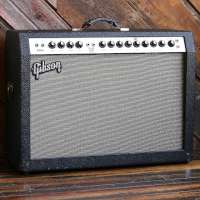
Tel-Ray Supernova with echo
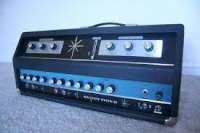
|
|
|
1966-1968
Vox V807 Standard Echo Reverb
Tube/tape
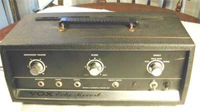
|
This Echo utliized an ESD unit very similar to the Tel-Ray "oil can", but without the oil. This was likely to work around the Tel-Ray patent and avoid the the Tel Ray license.
|
|
mid to late 60's
WEM Powercat
Tube/tape
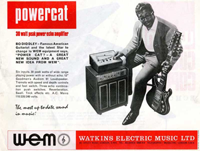
|
This version of the Copicat was part of a 15 watt (advertised as 30watt peak output) guitar combo/echo unit combination which was marketed by Wem as the "Powercat".
|
|
|
|
1966
Watkins The Shadow Echo
Solidstate/tape

|
A "budget" version of the Copicat with two playback heads
|
|
|
1965-66
Watkins Custom Copicat - MK III
Valve/Solidstate/tape
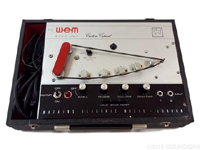
|
The Custom Copicat is a mixture of a Mk II valve Copicat and a solid state Mk IV Copicat, which is why it is often referred to as a Mk III. Now to add to the confiusion, there is a valve version and a solidstate version of the MK III. They look the same until you open them up, and Watkins used the same housing and faceplate for the MK IV. So you may not know if its an MK III or MK IV until you open the uniit. The Mk IV has the oscillator on a seperate pcb, the MK III it is intigrated to the main board with a shileding cover.
|
|
|
1966-68
Vox Echo Deluxe V837
Solidstate/tape
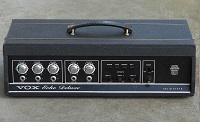
|
There were two models of the V837 Vox Echo Deluxe. One made in the US by Thomas Organ and one made in the UK by JMI. The features and functionality of the V837 Vox Echo Deluxe were nearly identical, but the US Thomas Echo Deluxe was transistorized while the JMI Echo Deluxe was vacuum tube.
The Thomas Organ (US) and JMI (UK) Echo Deluxe units both featured three channels. The front panels of both units had three high impedance input jacks, three rotary volume controls and three switches to disable the echo effect. The front panel of each unit also had a echo blend control, output jack and foot switch jack. The US V837 offered a rotary "Sustain" control, a feature not included on the front panel of the JMI unit. The "Sustain" on the V837 adjusted the amount of echo regeneration. The V837 and JMI Echo Deluxe units both had a chassis mounted regeneration limit control.
Both tape mechanisms incorporated a record head, an erase head and six playback heads.
Both units utilized the same tape cartridge as the Fender/Eccofonic EEC.
Configuration:
The Echo has a record/erase head and 6 playback heads.
Reverb enables the 2nd playback head.
Echo enables the 4th playback head.
Answer enables the 6th playback head.
Roll enables the first 5 heads in decreasing volume.
|
|
|
1967
Watkins MK IV
Solidstate/tape
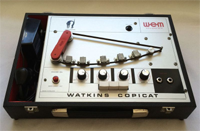
|
This model was produced in the greatest volume
|
|
|
1967-?
Dallas Arbiter Soundimension
Solidstate/Magnetic Disc

|
The Soundimension operated using a spinning magnetic drum and four fixed playback heads. A Duration control set the number of repeats while an Echo control set the wet/dry blend. Finally, a Volume control set the overall level of the effect. Five push buttons would activate five fixed delay times.
|
|
|
1967-?
Dallas Arbiter Soundette
Solidstate/Magnetic Disc
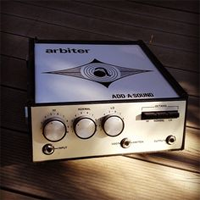
|
A smaller more compact version of the Soundimension, but with three fixed delay times.
|
|
|
1967-68
Fender Soundette (built by Dallas Arbiter)
Solidstate/Magnetic Disc
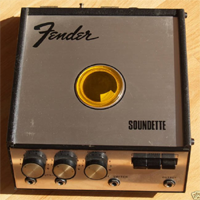
|
These were a rebranded version of the Dallas Arbiter soundette. A smaller more compact version of the Soundimension, but with three fixed delay times.
|
|
|
1966/67
Fender Electronic Echo chamber FE-1000
Solidstate/tape

|
With the FE-1000 the form factor was changed to match their new line of solid state applifiers. The internal circircuit and the Eccofonic style tape cartridge was still utilized, but with a longer wound tape. These units function almost identically to their earlier counter parts, but the pinch wheel is not longer activatied with a solenoid and the head alignment seems to be a bit more tricky. The main disadvantage I see is the missing solenoid on the pinch wheel as having the wheel contantly engaged to the drive shaft in storage leads to deformation and the pinch wheel being out of round. These were presumedly still built by Eccofonic, and again there was no sound on sound feature. This model was only aviable one year, late 1966 through 1967.
|
|
|
1968
Echoplex EP-2
Tube/tape

|
Desc
|
|
|
1969
Hohner Echo Plus
Solidstate/tape
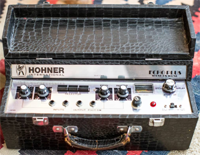
|
These models used a Sony tape loop cartridge and featuired a 3 Button selection for heads.They are fairly limited compared to other tape echo systems of the time.
|
|
|
1969
Bucket-Brigade Device (BBD)
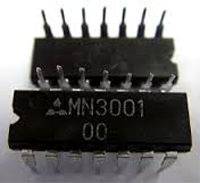
|
While not specifically an echo, this is definatley worth noteing that in 1969 F. Sangster and K. Teer of the Philips Research Labs invented the Bucket-Brigade Device (BBD). These would later revolutionize echo and delay with the first delay pedals.
|
|
|
Late 60's
Ace Tone EC-1
Solidstate/tape

|
Ace Tone/Rolands first tape echo design, the EC-1 Echo Chamber proved popular. Housed in a sturdy wooden box, the Ace Tone machines used a single-loop tape cartridge design common to tape echo machines of the day.
|
|
|
1960's
Iwase Voice Echo Machine
tube/tape
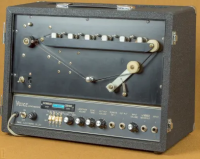
|
Mr. Iwase worked for Teisco during the 1950s before forming his own company Iwase Electric in 1965 and began producing guitars and amplifiers on a limited basis. Iwase electic closed shop in 1970. They did lots of one off work, so this could be a one of a kind. It features 4 playback heads, a separate output for the delay signal, a tone control and magic eye for input level metering, on/off switches for each head, as well as a switch that stops the motor and disengages the pinch roller. Fixed speed motor.
|
|
|
1970-91
Echoplex Ep-3
Solidstate/tape

|
This was the first solid state model echoplex. This unit enjoyed the longest production run of all the Echoplex models and was used by Eddie Van Halen, Tommy Bolin, Andy Summers, Jimmy Page, Brian May, and many other notable guitarists of the 1970s.
About the time of the public introduction of the EP-3, Maestro was taken over by Norlin Industries, then the parent company to Gibson Guitars.
|
|
|
1971
Echoplex EM-1 Groupmaster
Solidstate/tape
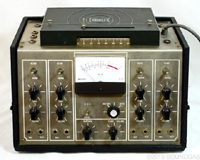
|
A four-channel input mixer section and a mono output section.
|
|
|
Early 70's
Ace Tone EC-10
Solidstate/tape
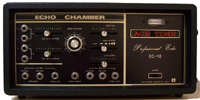
|
Ace Tone refined and developed the EC-1 design to become the Ace Tone EC-10.
|
|
|
Early 70's
Ace Tone EC-20
Solidstate/tape
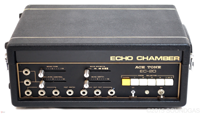
|
Ace Tone refined and developed the EC-10 design to become the Ace Tone EC-20. The Ace Tone units were notable however, for the fact that they used multiple playback heads that were user-selectable via the Mode Selector control. This arrangement allowed the user to create multi-tap, syncopated delays, depending on the combination of playback heads used. This feature became a hallmark of the Space Echo series to come.
|
|
|
1970s
JMX Hagstrom ET-520 Echo Machine
Solidstate/tape

|
The JMX ET-520 Echo Machine was the precursor to the famed Roland Space Echo and sold and licensed by Roland under various brands like Pearl and Vorg (under the name Echo Orbit).
|
|
|
1970's
Pearl EO-302 Echo Orbit-2
Solidstate/tape
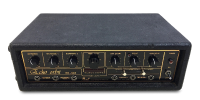
|
Precursor to the famed Roland Space Echo and sold and licensed by Roland under various brands.
|
|
|
1970's
Pearl EO-301 Echo Orbit-1
Solidstate/tape
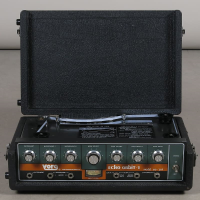
|
Precursor to the famed Roland Space Echo and sold and licensed by Roland under various brands.
|
|
|
1973
Roland RE-100 Space Echo
Solidstate/tape
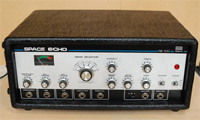
|
Like the earlier Ace Tone machines, the Roland RE-100 featured multiple playback heads but also added BASS and TREBLE tone controls that allowed the user to shape the tone of the repeats. This model utilized a Sony tape loop cartridge like the old Hohner Echo PLus.
|
|
|
1973
Roland RE-200 Space Echo
Solidstate/tape
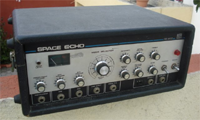
|
Just like the RE-100 the Roland RE-200 featured multiple playback heads and BASS and TREBLE tone controls that allowed the user to shape the tone of the repeats, but the RE-200 featured an added spring reverb. This model utilized a Sony tape loop cartridge like the RE-100 and the Hohner Echo PLus.
|
|
|
1974-1990
Roland RE-201 Space Echo
Solidstate/tape
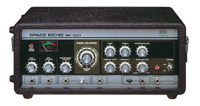
|
The RE-201 featured circuit upgrades to improve the overall tone of the machine, but the truly forward thinking feature was the completely redesigned tape transport mechanism. The RE-201 tape transport mechanism used only a single capstan for transport and left the ¼-inch tape freely “floating” within the tape chamber. This design improved not only the tonal fidelity of the delay repeats, but also provided much greater reliability than any machine before it and greatly reduced the wear and tear on the tape itself.
|
|
|
1974
Roland RE-101 Space Echo
Solidstate/tape
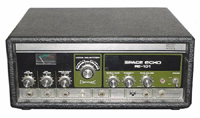
|
With an identical echo circuit and tape mechanism to its bigger brother, the RE-101 was scaled back by omission of the 2-band EQ and the spring reverb effect.
|
|
|
1975
WEM Halle Cat Echo/Reverberation/mixer Unit
Solidstate/tape
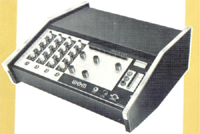
|
Somewhat of a rarity, the Halle Cat was designed as a Copicat with combined 4-channel mixer. It was later dubbed "Too expensive - too complicated" by Charlie Watkin and was discontined. The Halle cost £250 in 1975 when the standard Copicat cost £76.
|
|
|
1977
Roland RE-301 Chorus Echo
Solidstate/tape
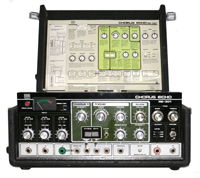
|
The RE-301 distinguished itself by adding two new features. The first was a lush, analog chorus effect that was able to be used concurrently or independently from the delay effect. Additionally, the RE-301 added a new “Sound on Sound” mode, allowing users to loop phrases and then record additional layers on top.
|
|
|
1975-1979
Echoplex Ep-4
Solidstate/tape
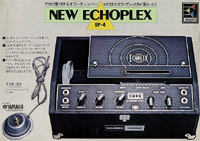
|
The second solid state model. Upgrades include a new output buffer, LED metering, as well as treble and bass controls.
|
|
|
1970's
Teisco Sound Repeater SR-73
Solidstate/tape
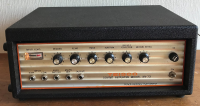
|
The Sr-73 used the Sony endless tape, a popular choice in the early 1970s as it was used by Roland, Elk and others. The three delay selections for the effect and speed control to vary the sound.
|
|
|
Early 70's
Echoplex ES-1 "Sireko" (Sir-Echo)
Solidstate/tape
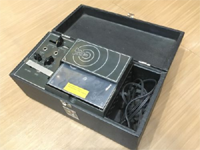
|
An economy model with the same electronics without sound on sound, but they used a different tape cartridge.
|
|
|
1977
WEM COPICAT "SUPER IC" MODEL
Solidstate/tape
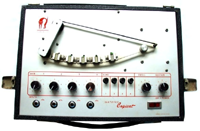
|
The Super-IC looks very similar to the IC300. The main differences visible from the outside are:
The cable compartment is inside the machine behind a hinged door on the rear panel.
On the IC300 it is on the left hand side like many earlier Copicats.
It has 4 replay heads/switches. The IC300 has 3 plus a tone switch.
The Echo Send/Retrun socket is in the back compartment. On the IC300 it is on the front panel.
|
|
|
1977
WEM COPICAT "SUPER IC" Sound on sound MODEL
Solidstate/tape

|
Same as above with a SOS "sound on sound" switch which turns off the erase section of the Z-Combo head, diverting the bias signal to the record head while in SOS mode.
|
|
|
1977
Korg stage echo
Solidstate/tape
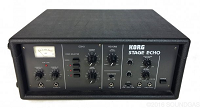
|
Korg was able to marry many successful elements of the Space Echo with features that would please their synthesizer and guitaz customers.
CV control of the delay time for the studio and synth head, sound on sound for the guitar guys.
|
|
|
1978-81
Korg stage echo SE-300
Solidstate/tape
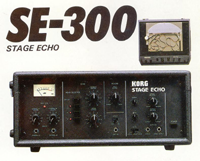
|
The RE-300 offered spring reverb integrated and very flexible mixing and routing options between dry/delayed signal and the reverb tank.
1978 was also the year that saw Roland launch their first BBD chip-based analogue echoes (the DC-30 and DC-50), whose maintenance-free reliability and portability were the beginning of the end for tape echoes.
|
|
|
1978-81
Korg stage echo SE-500
Solidstate/tape

|
The SE-500 had a long delay feature with repeats up to a whopping 1500ms, impressive for a tape echo at the time (remaining so to this day). The long delay and three other playback heads could be switched in and out independently or in combination for a range of patterns. The Stage Echos compander-based noise reduction system made for a cleaner-sounding tape echo certainly more HiFi than those that had gone before. The addition of balanced inputs/outputs on XLR sockets reinforced the SE-500s position as a serious studio machine for the professional user.
|
|
|
1979-80
WEM COPICAT "IC 300" MODEL
Solidstate/tape

|
The solid state technology of the IC 300 differs from the Mk3 and Mk4 units which were also named as the w-e-m Solid State but were all transistor units, while the IC-300, from its name, has been designed with ICs, otherwise known as integrated circuits. These ICs are single 741 op-amp ICs, 741 being the IC type number. op-amp = Operational amplifier. As stated it is a single op-amp, of which there are four of them in the whole range of IC Copicat machines. One would be a pre amp, one the record amp, one the playback amp and finally the wet dry mix output amp.
The bias oscillator is a transistor device much the same as the earlier Mk4 units.
|
|
|
1979
Roland Re-150 Space Echo
Solidstate/tape
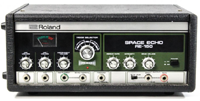
|
Although it looked very similar to the RE-101 and contained the same core circuitry and mechanisms, the RE-150 differed in that it contained only 2 playback heads (1 less than the RE-201), limiting the number of mode variations available to the user. Like the RE-101 it also lacked reverb. Interestingly, the RE-150 had the unique feature of offering two separate outputs one for the Direct (Dry) signal only and one for the affected signal a feature that found favour with many players.
|
|
|
mid/Late 1970's
Hawk 2150
Solidstate/tape
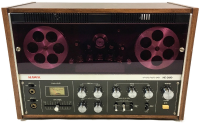
|
Hawk Technical Works Co Ltd put out a range of tape echoes and spring reverbs branded Hawk/Mirano aimed squarely at domestic home recordists. With three switchable replay heads: Off, Super-Repeat (at 0db), Repeat and Swell (at -6db) and controls for tape speed, input level (for echo and dry signal), echo level/repeat/tone and master output it was a full featured tape echo
|
|
|
mid/Late 1970's
Hawk HE-2250 Reel Tape delay
Solidstate/tape
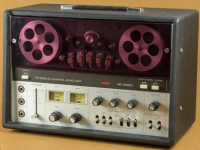
|
The HE-2250 was a true stereo delay. It kept the left and right channels completely isolated from each other, each with its own delay settings (feedback, depth, tone, head selection), or can provide a variety of ping-pong and switched-channel delays. Heads can be set to super repeat or repeat and swell mode, independently for each channel. With output settings for dry, mix and echo only switchable for both channels this unit had it all.
The HE-2250 also provided two unique buttons due to its stereo capabilities: reverse echo and mirage. The first one sends the delayed signal to the opposite channel, so the left channels echo is on the right, and vice-versa. The mirage setting created ping-pong delays alternating between each channel.
|
|
|
Late 70's
Multivox MX-201
Solidstate/tape

|
It's basically very similar the Roland Space Echo. Endless loop tray, 5 heads for echo, spring reverb, plus it does single/plural sound-on-sound, variable speed, and a "Swell Reverb" option.
|
|
|
Late 70's
Multivox mx-312/Evans SE 780
Solidstate/tape

|
It's basically very similar the Roland Space Echo. Endless loop tray, 5 heads for echo, spring reverb, plus it does single/plural sound-on-sound, variable speed, and a "Swell Reverb" option.
|
|
|
late 70s- early 80s
Univox EC100/EC80
Solidstate/tape
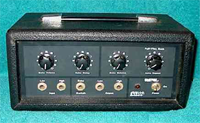
|
There were two versions, basically they were almost identical design wise. They all used a Apollon HD-5000 Recording Tape cartridge. These cassete tape based echos were built in Japan and marketed under many names.
Univox EC100/EC80
Melos Echo Chamber
Melos Em150
Echolix EM-110
|
|
|
late 70s - early 80s
Melos EM-3000 Disc Echo
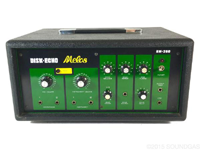
|
These machines are fairly rare because of the unique method they use to generate the echoes - heads positioned above a spinning magnetic disk, not unlike an old computer floppy disk. The idea was to make a machine where changing the recording surface was easy and did not necessitate re-aligning the heads, but unfortunately since they stopped making the replacement disks have become pretty much impossible to find. They were produced around the beginning of the 80s and can also be found in various colours badged Echolette, JBX, Monacor, Montarbo and Univox.
Univox Echo-Tech EM-200
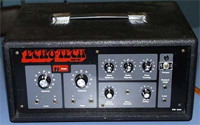
|
|
|
late 70s
Mirano Echo Chamber 3
Tube/tape
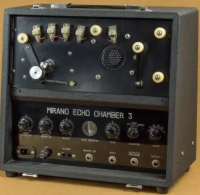
|
Echo selections: Off, Echo, Repeat.
Controls: Mood, Tone, Repeat, input Power SW, Output power SW
Fixed motor speed
Made in Japan by Hawk Technical Works.
|
|
|
late 70s
Mirano echo chamber T4
Solidstate/tape
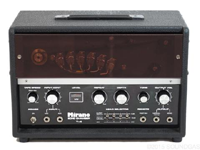
|
This unit has all the basic features needed for a good tape echo, including elaborate control over head selection, a tone knob, a wet only output and variable speed.
Made in Japan by Hawk Technical Works.
|
|
|
70's
Electra FLatresponse Ep-350

|
echo/reverb, cathedral reverb, as well as allows mixing of the two. Also comes with bass, treble, and volume controls. The echo duration and repeat can be adjusted. Has 3 inputs, 2 outputs, headphone.'
|
|
|
1970's
Rexer Tape Echo RTE-3000
solidstate/tape

|
The 3000 has a automatic motor shut-off circuit that detects no signal present and not only stops the tape loop but shuts the motor down for increase motor, head and loop life. Stereo outputs, 3 playback heads, echo tone control, 70-800ms,
Also marketed under Guyatone name.
|
|
|
late 1970's
Guyatone EM 606
solidstate/tape

|
Controls Speed, Repeat, Echo vol, Bass, Treble. 2 inputs with independant volume control. 8-track cartridge unit with limited features.
|
|
|
Late 70's?
Russian ESKO-100
Solidstate/tape
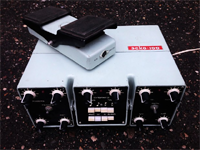
|
The ESKO-100 was engineered on Ural's company VECTOR and produced on the FORMANTA factory as the legendary POLYVOX.This is not a simple tape delay unit - there are two independent sections with separate input/output
with more additional analog effects. 3 delay times is fixed with buttons - You can use for any from 3 delay times simultaneous.
Input/Output sockets are 5-DIN connectors
Right section - mic-in 1-2 levels, reverb level, echo level, power on
Left section - guitar-in level, organ-in level, pedal on/off, reverb level, echo level
Middle section - vibrato depth, vibrato freq, fuzz on, shmitter, organ, vibrato on, 4 variations knobs.
|
|
|
Late 70's?
ELK Em-3 Echo
Solidstate/tape

|
Utilized Sony endless tape loop with 4 inputs and controls for Repeat, Echo, and Reverb. The unit also featured a standby switch to disengage the motor. Two foot switch jacks, one the delay can be stopped smoothly where what is left of the delayed signal trails off instead of cutting off suddenly and one that cut off suddently.
|
|
|
?
ELK Em-4 Echo
Solidstate/tape
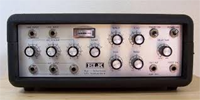
|
Utilized Sony endless tape loop with 3 inputs and controls for Repeat, Echo, Bass, Treble and Delay time. The unit also featured
a standby switch to disengage the motor.
|
|
|
?
ELK Em-5 Echo
Solidstate/tape

|
Utilized Sony endless tape loop with 2 inputs and 3 selectable echos Slow,Swell, Fast and adjustments for Repeat, Echo, and Speed. Standby switch to disengage motor.
|
|
|
1970's
Kastam Concert SS-100 Echo Chamber
solidstate/tape
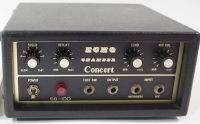
|
Controls for Speed Repeat, Echo and Mic Volume. Utilizes 8 track cartridge.
|
|
|
1970's
Kastam SS-102 Echo Chamber
solidstate/tape
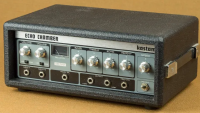
|
Also released under Guyatone EM-808D
8 Track echo.
|
|
|
1982
Roland RE-501/SRE555 Chorus Echo
Solidstate/tape

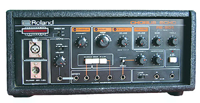
|
The RE-501/SRE-555 were essentially the exact same machine, but built into two different form factors; the RE-501 keeping the classic tolex-covered wooden box of the Space Echo machines before it, whilst the SRE-555 took the form of a large 19” rackmountable chassis. Cosmetically they departed from the classic green/silver colour scheme in favour of black/orange – to match Roland’s popular range of digital rackmounted processor units being produced at the time. A more modern LED display replaced the traditional VU meter. Functionally, the RE-501/SRE-555 contained all of the same features of the RE-301, but the new design reduced noise and also added a fourth playback head to provide the user with even more tonal variety. It was the most advanced (and quiet) Space Echo.The RE-501/SRE-555 proved to be the last tape-based design that Roland ever created.
|
|
|
1982
Tesla StudioEcho
Solidstate/tape

|
A tape echo machine built in Czeckoslovakia
|
|
|
1980's
Guyatone Em-77 Echo Chamber
solidstate/tape
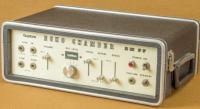
|
Two playback heads, Utilizes Sony endless tape loop cartridge.
|
|
|
1980's
Guyatone Em-88 Echo Chamber
solidstate/tape
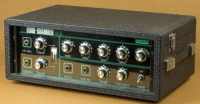
|
variable speed, tone control, wet output, tape spaced for heads for longer delays, and also includes a spring reverb. Utilizes long tape loop.
|
|
|
1980s
Russian ECHO-1
Solidstate/tape

|
Tape delay had 5 independent channels you could use for any of the 5 delay times simultaneous. The controls for these were on/off, level, play/record amount, "reverberation" on/off. All Input/Output sockets were standard 5-DIN connectors. The unit utilized a stadar tape loop. The tape motor had an on/off, so the tape loop could be preserved. The power supply was switchable 127V(110)/220V(240).
|
|
|
2000's ??
VOCU VTE-1600 Analog Tape Echo
Solidstate/tape
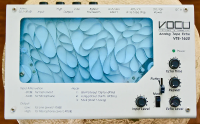
|
Vocu stands for Vivid Output and Capable Unit. These use the same loops as the Roland Space echo range – it's a full-featured tape echo that’s a little larger than a paperback book.
Accepts mic, instrument or line level inputs, has three delay modes – 150-600ms, 500-1600ms and a combination of both short and long heads. Has mix/wet-only switch (Cue/Mix Direct) for use as an effects send, controls for Master Level, Echo Time, Repeat and Echo Level as well as Input Level. The Flutter control engages an off-centre plastic wheel against the pinch roller to introduce extra warble and sense of a machine less well-maintained (the lever will rest at the mid point giving a sensible level of flutter, or can be pushed harder against the pinch roller for momentary bouts of extra warbliness). It takes a 15v centre positive power supply.
|
|
|
2000's ??
Hiwatt CTE-2000C Custom Tape Echo
Solidstate/tape
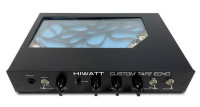
|
Slim-line, compact tape delay made by Fernandes for Hiwatt - almost identical to the "Vocu" version.
|
|
|
2004
Fulltone Tube Tape Echo
Tube/tape
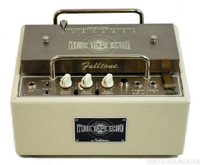
|
The Fulltone TTE is based on the tube-driven Maestro Echoplex EP-2 unit of the 60s and replicates those vintage tape delays perfectly and reliably.
https://www.fulltone.com/products/custom-shop-tube-tape-echo
|
|
|
2015
Trex Replicator
Solidstate/tape
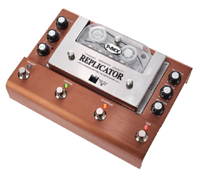
|
The Replicator is T-Rex Engineeringâ–’s take on the ultimate tape echo unit, complete with a motor, magenetic heads and a tape cartridge. The goal was to make a tape echo unit that could nail the sound quality of the old echo units, but surpass them in features. Size, ease of use and super-fast tape replacing were obvious areas of improvement, but we also put in tap tempo, two playback heads for three output modes and a chorus mode that modulates the pitch of the echos.
Two expression pedal inputs allow the player to control delay time and feedback in real time for instant synth-noise at your feet.
The tape cartridge (available seperately) can be replaced in seconds and the high headroom of the circuit will allow you to use this pedal for processing line signals as well (keyboards, P.A. aux sends, preamps, etc.).
The difference between a super precise, accurate digital echo and the Replicator is that there is a certain amount of unpredictability in the sound of tape. It has its own life, almost. And that personality translates into a very natural sounding echo that we think feels more like an instrument than a sound effect.
https://www.t-rex-effects.com/replicator
|
|
|
2016
Fulltone Custom Solid State Echo
Solidstate/tape
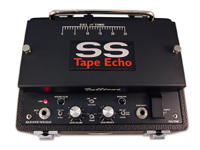
|
Mike Fuller of Fulltone's interpretation of the Maestro Echoplex EP-3 solid-state delay unit. The SSTE is more of a homage and not a direct copy of the EP-3.
The SSTE has an identical TIS58 JFET circuit to the first EP-3 produced, which allows you to achieve those cutting highs without the bass muddying up your tone.
https://www.fulltone.com/products/custom-shop-solid-state-tape-echo-v2
|
|
|
2017
Trex Replicator junior
Solidstate/tape
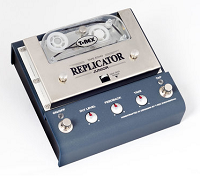
|
The Replicator junior is the same as the replicator without all the bells and whistles.
Equipped with the same basic circuit as the big unit, you still get all the goodies that a tape echo offers,
A single playback head with three controls for level, feedback and time makes tweaking a set-and-forget affair.
It does not get any simpler than this; tap tempo, kill-dry switch and a saturation control.
HANDCRAFTED IN DENMARK
https://www.t-rex-effects.com/replicator-junior
|
|
|
2019
Echo Fix EF-X2
Solidstate/tape
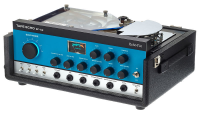
|
The EF-X2 is a new Tape Echo with Spring Reverb, DSP Reverb & Chorus.
* Tape delay with reverb
* 3 Main functions: Tape delay, reverb and preamp
* 7 Different echo modes
* Real spring reverb and DSP reverb modes: Spring, DSP or Blend
* Separate inputs and volume controls for instrument and line levels
* Balanced inputs and outputs on the back
* Direct ON/OFF: Switches the direct signal off or on
* Motor ON/OFF: Allows the tape drive motor to be switched on and off to achieve the tape stop effect or to increase the life of the tape
* Sound On Sound ON/OFF Switch: Activates an additional playback head (loop or overdub function)
* Echo ON/OFF: Bypasses the band circuit for use as a pure reverb with preamp (instrument input)
* Echo time and feedback controllable via CV
* Mute the reverb or delay signal with a double foot switch
* Colour: Black
* 2 Tape loops included
|
|
|
2022
Echo Fix EF-X3
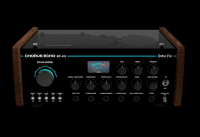
|
The Echo Fix EF-X3 comes equipped with Analog BBD Chorus & Analog Spring Reverb, and boasts a 100% analog signal path.
Direct playback head outputs allowing for external panning for stereo ping pong delays from a mono source
*Analog BBD Chorus with rate and depth controls
*Analog Spring Reverb
*Independent SOS switching for longer delay time (1.2 seconds)
*Direct WET output at rear for Reverb/Chorus
*Balanced Input and Output at rear
*Auto tape stop when no audio signal present to extend tape and motor life (There is a switch at the rear to disable this feature).
*CV Control for Motor Speed and Feedback level (0-5v) via compatible Expression Pedals
*Bass and Treble Controls (Echo Signal)
*Vintage Guitar/Line FET Preamp (Front Panel)
*High/Low Output level switch (Front Panel Output)
*Four echo playback heads (including SOS head)
*Motor ON/OFF Switch for tape slow down effect
*Mute the reverb, echo and chorus signal via remote foot switches
*Comes with a worldwide-compatible, 100 - 240v power supply (no step-down or other transformers required)
*2 Years Warranty
*Removable Tinted Acrylic Lid
*High quality scratch resistant front panel
*2 Tape loops supplied with each unit
*Two front Panel colour options - Silver or Black
*Wood Sides
*Mode 1 - Head 1
*Mode 2 - Head 2
*Mode 3 - Head 3
*Mode 4 - Head 1 + 2
*Mode 5 - Head 2 + 3
*Mode 6 - Head 1 + 3
*Mode 7 - Head 1 + 2 + 3
*Sound On Sound is another head that can be switched on over the top of all the head mode settings or you can use the SOS head independently.
*Tape Speed - 4 IPS to 15 IPS
*Weight: 12Kgs
|
|
|
2023
T-Rex Binson Echorec
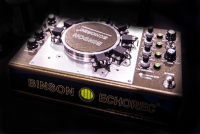
|
At the NAMM 2017 show, T-Rex debuted their Binson Echorec prototype. T-Rex purchased the original Binson/Echorec name and did a new recreation of the legendary echo. The status of the project was in limbo for a while with the T-Rex bankruptcy in 2019. The original founders of T-Rex Engineering, Sebastian Jensen and Lars Dahl, have since purchased back the brand and rebooted the company.
Trex finally has their recreation of the Binson Echo rec (complete with magic eye) available, or at least available for order which debuted at the 2023 NAMM show.
|
 |
|

|
|
|
Copyright © HewittsGarageStudio.com, all rights reserved |
|
|
|
| |